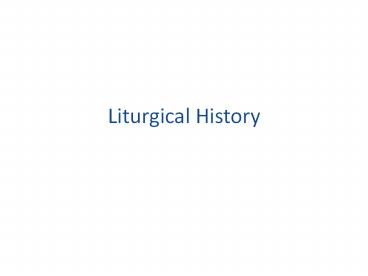Liturgical History - PowerPoint PPT Presentation
1 / 16
Title:
Liturgical History
Description:
Liturgical History Liturgical History We saw how in the Plan of Salvation, worship of God is present Cain & Abel, etc. Moses, let us go into the wilderness for 3 ... – PowerPoint PPT presentation
Number of Views:245
Avg rating:3.0/5.0
Title: Liturgical History
1
Liturgical History
2
Liturgical History
- We saw how in the Plan of Salvation, worship of
God is present - Cain Abel, etc.
- Moses, let us go into the wilderness for 3 days
to give sacrifice to our God - As the people grew in understanding of God and
their relationship to him, rituals developed
3
- At the Last Supper the meal is transformed and
God gives food to man. - Worship in the NT includes the morning/evening
prayer, blessings, prayers of the synagogue, NO
more need for animal sacrifice.
4
- The word liturgy has been in use for only about
two centuries. - Stages
- Apostolic period-ends at death of apostles
- Minority and semi-clandestine up to 4th century.
- Constantines Peace
- National leaders convert, followed by their
citizens - Period of stability/rigidity from Council of
Trent (1560s) to Vatican II - Faith and reason necessary for study of liturgy
- Early centuries had few books so much has been
lost to history
5
- Each Church developed their own traditions
- Finally was written. Just like NT, after the
witnesses to Jesus died, it is important to keep
for history what they had said about Jesus. - Not to say that there was standardization. Even
in Rome, every basilica had its own liturgy. - Different Families of Churches (rites) emerged
- Roman Church and the Churches of Antioch and
Alexandria
6
- Eastern Churches their anaphoras usually
distinguish one from another - Emphasis in this unit is on Roman Rite
- Documents available to us
- Liturgical books, letters of bishops
- Sacramentaries just prayers of the bishops.
Leonine or of Verona, on example . Pope Leo the
Great, so from at least about 440. - Lectionaries and books we call Liber Pontifical,
Ordines romani
7
- Original liturgical language was Greek
- Latin was next from about 375. Because of
Byzantine arrivals in the West, Mass was
bilingual in places and Eastern customs were
incorporated Marian feasts, veneration of the
cross, and others. - Middle Ages Each Church evolved their own
customs and books varied from place to place.
8
Council of Trent (1545-1564)
- Defend the Church
- Counter Reformation
- New Missal and other liturgical books published
for consistency
9
Liturgical Movement
- France and Germany
- 1833-Abbey of Solemnes (France, Abbott Prosper
Gueranger) - 1921-Abbey of Maria Laach (Germany, Fr Odo
Casel) - 1927 Fr Romano Guardini- Cath Youth Movement
(1939, he escapes from the Nazis-he was a threat) - Bilingual missals were printed
- Hymns sung by the people in vernacular
- Trent had checked the liturgy for the sake of the
Truth - This movement saw a pastoral need to open it up
to renewal
10
Liturgical Movement
- Pope St. Pius X
- 1903 He first wrote of active participation in
a document on sacred music - 1910- Encouraged First Communion at age of reason
- Piux XII
- 1943 Mystici Corporis
- 1947 Mediator Dei
- 1955 Holy Week and Easter Vigil reform
- 1957 changed Eucharistic fast to 3 hrs
11
- John XXIII (1958-1963)
- 1959- Announces II Vatican Council
- 11Oct 1962 II Vatican Council begins
- Return of catechumenate
- Added St. Joseph to the Roman Canon
- Other changes to the Mass
12
Sacrosanctum Concilium
- 1st document of Vatican II Council
- 4 Intentions
- Sanctify
- Update
- Foster ecumenism
- Evangelize
- Lex orandi, lex credendi
13
SC (cont.)
- Motive increase of holiness
- Church is not like any other institution its
been founded by the God made Man. - Pastoral reasons main reason for reform of the
liturgy - First time in history, that other rites were
acknowledged of equal right and dignity.
14
SC (cont)
- Chap. 1 Major principles
- Chaps. 2-7 special sections, but most details
left for afterwards. - Liturgical reform with the publication of various
documents, the Rites, a revised liturgical
calendar, revised Liturgy of the Hours. 2nd
editions now being published.
15
More Recent documents
- Revised rituals of the sacraments
- Canon Law-1983
- Catechism of Catholic Church 2nd ed 1997
- 3rd ed GIRM
- Redemptionis Sacramentum
- Homilies, audiences of Holy Father
- Responses of Congregation for Divine Worship and
Discipline of the Sacraments - Documents of ACBC, individual dioceses
- (not exhaustive list)
16
Today the text and rubrics of the Roman Liturgy
are found in the Liturgical Books of the Roman
Rite 1. The Roman Calendar 2. The Roman
Missal (newest 2011) 3. The Roman
Lectionary 4. The Roman Pontifical 5. The
Roman Ritual (all the sacramental rites) 6.
The Liturgy of the Hours 7. The Book of
Blessings 8. The Martyrology































